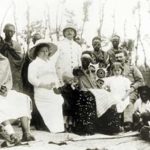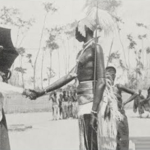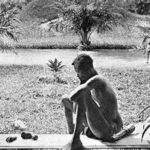The Functionalist Model of Rwanda
BEFORE EXPLAINING the significance of my focus on ethnicity, patron–client relations, and labor-control practices as dynamic elements related to the growth of state power, I want to show why the prevailing models of the 1950s and 1960s distorted or neglected these elements and how new empirical research can bring them to the fore. I have focused on these in part because of their importance to Rwandan political development, in part because their processual aspects havebeen so neglected.
The prevailing model of Rwandan political organization arose from an attempt by social scientists to explain how integration in the society was possible despite the political domination of the population at large (mostly of Hutu identity) by a minority ethnie group. According to the most reliable colonial census available, that of 1956, Hutu constituted about 83 percent of Rwanda’s population in that year; Tutsi, 16 percent; and a third group, the Twa, about 1 percent. Yet virtually all positions of power and prestige were held by Tutsi, and cattle (one of the major forms of wealth, whose transfer served as an important representation of social relations), were predominantly owned by, or their transfer controlled by, Tutsi. Social scientists who studied Rwanda during the 1940s and 1950s assumed that the ethnic and class stratification between Tutsi and Hutu, as it existed at that time, had been unchanging features of “traditional” Rwanda.
The work of Jacques-Jean Maquet has been perhaps the most influential in this regard, for many of the later studies accepted the general lines of his view of precolonial Rwanda. Inhis 1954 study, Le système des relations sociales dans le Rwanda ancien, Maquet relied on the concept of “caste” to characterize what he saw as the rigid separation between the three principal groups and the hierarchical unchanging character of relations between them. In this presentation, Tutsi pastoralists, although a minority, held all political power, controlled most sources of wealth, and exploited their agriculturalist Hutu subjects. Despite the imbalance in numbers and the evident inequality in the society, social and political cohesion was assured, Maquet argued, through three mechanisms: value consensus, expressed in a communally-accepted “premise of inequality”; ubuhake cattle clientship; and a complex system of administrative arrangements. As conceptualized by Maquet, the premise of inequality involved a consensus that all
Rwandans are by birth fundamentally unequal. Such value consensus implied an acceptance on the part of the dominated that some (in this case Tutsi) are born to rule and to exploit, while others (Hutu and Twa) are born to obey and to serve.
In Maquet’s view, integration in such a society resulted from the ubuhake clientship institution, whereby Tutsi pastoralist patrons granted the use of cattle to particular Hutu who were their clients. Although Tutsi ultimately controlled the use and distribution of cattle, cattle clientship (represented in the loan of cattle) provided Hutu cultivators with both access to cattle and juridical protection, as a patron was expected to protect his client. According to Maquet, this institution incorporated all Rwandans within a dense network of reciprocal, if imequal, ties. Therefore, he argued, clientship moderated the exploitative aspects of the system: it provided a place, a status, within the hierarchical system. Even Tutsi patrons of Hutu were clients of yet other Tutsi; in theory the only person ultimately not a client in this system was the king himself.
Moreover, Maquet argued, the Rwandan state was organized administratively so that there existed built-in competition between local authorities who competed for royal favor. A provincial chief did not exercise the full scope of political powers within a given geographical region; the centralized character of the Rwandan polity provided for competing jurisdictions among political appointees, and this situation gave Hutu opportunities to utilize alternative channels of appeal in cases of grievance. The establishment of the premise of inequality, ubuhake dependency relationships, and the Tutsi-dominated state, Maquet believed, had occurred too far in the past to be empirically studied.
Maquet expected that only extemal influences could disturb the Rwandan “equilibrium.” But, if precolonial Rwanda was both highly stratified and yet also well integrated, despite (or because of) the inequality, then what accounts for the explosion of hatred against Tutsi chiefs and the widespread manifestations of protest that occurred among Hutu in Rwanda during 1959-1961? Attempts to explain this violence have varied in the emphasis they place on class or ethnicity. However, most interpretations, foIlowing (with some modifications) Maquet’s portrayal of precolonial Rwanda, have assumed that ethnic groups in Rwanda were primordial and the stratification between them was static and unchanging. They also assume that ethnic stratification was changed but little during colonial rule.
In accounting for the radical political transformations of the terminal colonial period, such analyses then place great stress on externally derived social, economic, and ideological changes introduced by Europeans. Particularly important in this regard was the introduction of Christian ideas and especially the rationalist concepts of liberté and egalité (if not also fraternité): The spread of new ideologies through the system of mission education and the printed media was seen to undermine the previous assumed value consensus—the prernise of inequality—and the introduction of elections in preparation for independence from Belgium provided for the expression of ethnic (or class) solidarity which had previously been inhibited by the crosscutting ties of clientship. The impact of these changes was to destabilize an earlier “equilibrium” and ultimately to erode the legitimacy of the ruling elite. Internal social change and especially political struggle were almost entirely neglected for most areas of Rwanda. This version of why revolutionary protest occurred in Rwanda is only partially correct. While it is true that changes during the colonial period eroded the legitimacy of Tutsi rulers and that the spread of new ideologies was important in the revolution, this is inadequate as an explanation: it is based on a view of precolonial Rwandan society that is seriously flawed, and it ignores certain crucial aspects of changes in Rwandan political structures during the colonial period—changes that indicate just how legitimacy was eroded and in what way ideologies were important. Maquet’s conceptualization of precolonial Rwanda reflects elements of an ahistorical functionalist view of social systems. Selected features drawn from diverse time periods are combined into a synchronic model said to represent a particular society that endured over a span of many years. The model assumes a social system in equilibrium, and focuses on those features that function to maintain such equilibrium.
https://uk.amateka.net/the-functionalist-model-of-rwanda/https://uk.amateka.net/wp-content/uploads/2020/04/haut-le-mains-1024x576.jpghttps://uk.amateka.net/wp-content/uploads/2020/04/haut-le-mains-150x150.jpgChanges and ColonialismBEFORE EXPLAINING the significance of my focus on ethnicity, patron–client relations, and labor-control practices as dynamic elements related to the growth of state power, I want to show why the prevailing models of the 1950s and 1960s distorted or neglected these elements and how new empirical research can bring...BarataBarata rpierre@ikaze.netAdministratorAMATEKA | HISTORY OF RWANDA




